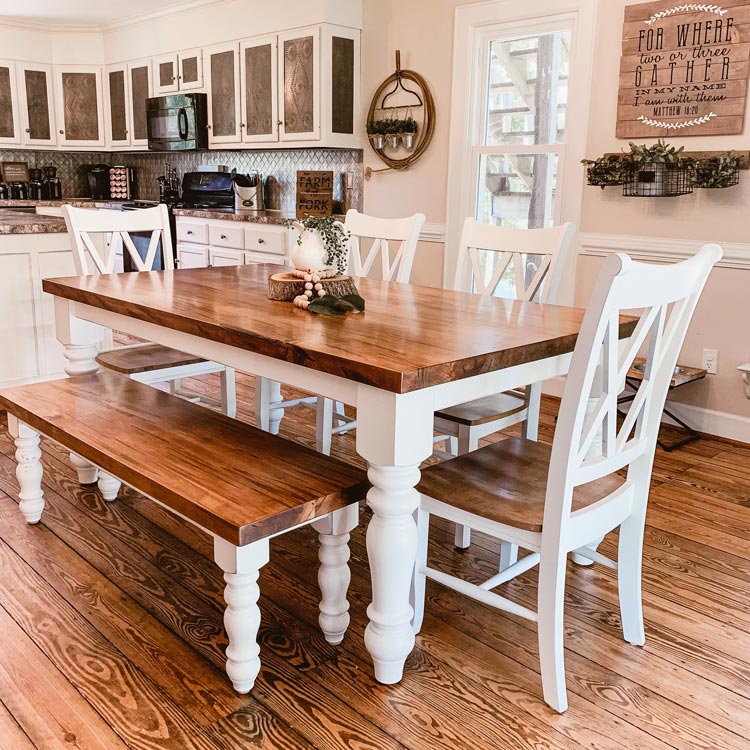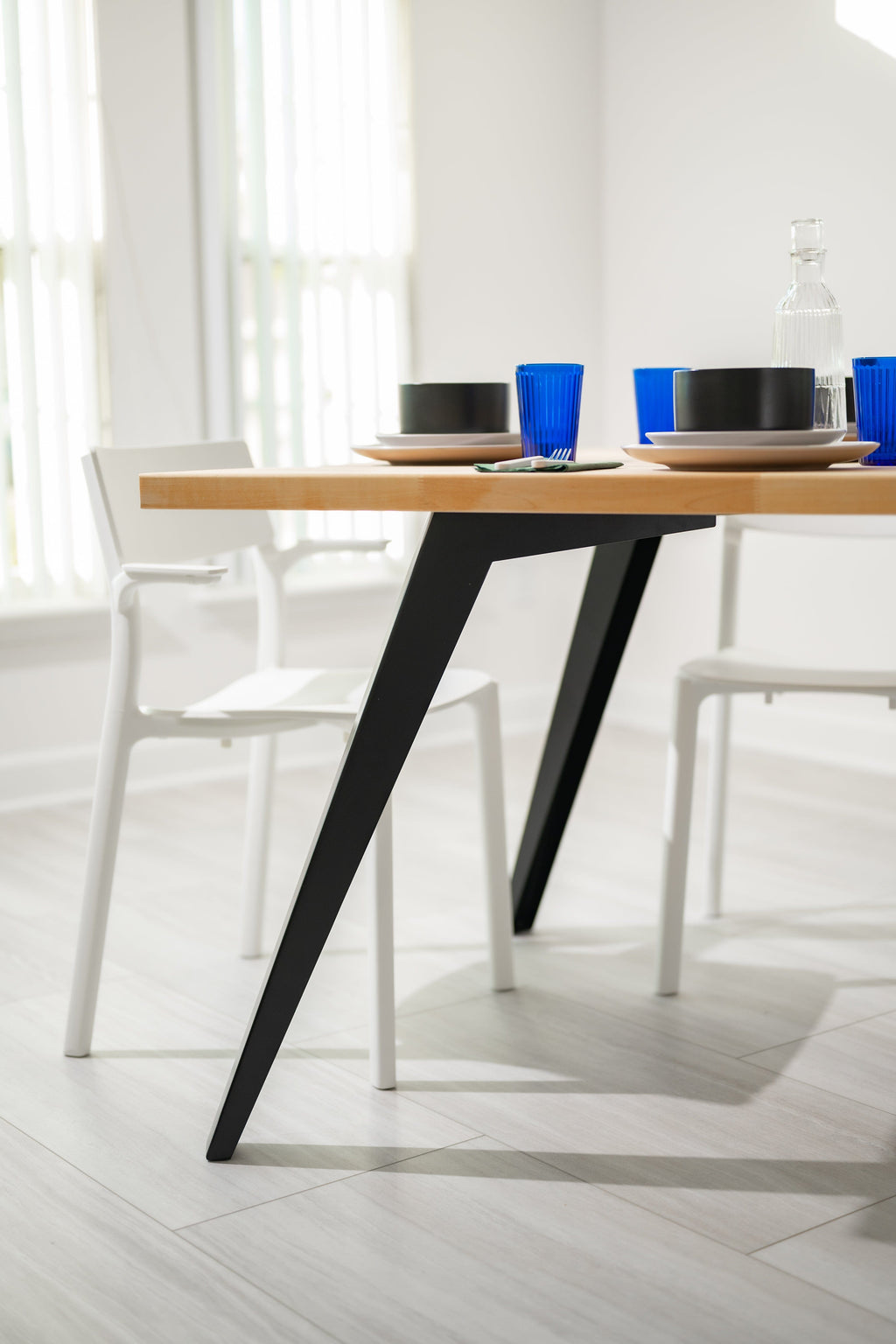Add Charm and Elegance to Your Space with Distinct Dining Room Table Legs
From Typical to Modern: Locate the Perfect Dining-room Table Legs for Your Style
The choice of eating area table legs plays an essential duty in specifying the general character of your room, linking the void between traditional workmanship and contemporary appearances. While traditional styles such as cabriole and transformed legs stimulate a sense of classic sophistication, modern styles like hairpin and geometric alternatives offer a possibility for striking visual interest. Assessing the appropriate balance in between these styles needs a nuanced understanding of your existing decoration and personal taste. As you consider these components, the concern continues to be: how can you flawlessly incorporate these diverse leg styles to develop an unified dining experience?
Understanding Table Leg Styles
The variety of eating room table leg styles can dramatically affect both the appearances and performance of the room. Each leg design contributes one-of-a-kind functional features and visual aspects, accommodating diverse style preferences and use demands. Understanding these styles is crucial for choosing the best table that aligns with your overall interior design vision.
As an example, conical legs provide a clean, classic appearance that can boost a space's style, while stand bases offer stability and maximize legroom, making them optimal for smaller rooms. Barrette legs, a hallmark of mid-century modern layout, present a commercial flair, enabling an airy, open feel. Similarly, trestle legs evoke rustic appeal, giving robust support and a sense of timelessness.
Additionally, the choice of products plays a considerable function. Wooden legs can bring heat and structure, whereas metal choices often share a streamlined, modern ambiance. Ultimately, comprehending table leg styles is vital for developing a natural eating location that mirrors personal style while making sure usefulness and convenience. By attentively considering these aspects, you can boost both the aesthetic and useful appeal of your eating area.
Typical Table Leg Options
When choosing dining-room table legs, standard options usually embody classic sophistication and craftsmanship. These styles mirror an abundant heritage and a dedication to high quality, making them suitable for those who value traditional aesthetics.
Among the most legendary typical leg designs is the cabriole leg, characterized by its elegant rounded form. This layout often features attractive makings and is most generally found in Queen Anne and Chippendale furnishings. One more popular alternative is the transformed leg, which flaunts a series of smooth, rounded forms that offer a timeless look while maintaining stability.
Additionally, the straight leg, while easy, offers a durable and unadorned structure that can mix effortlessly with a range of tabletop styles. For those attracted to ornate detailing, claw-and-ball feet legs evoke a feeling of majesty and can act as a stunning focal point in any type of eating area.
Last but not least, stand bases, although not purely legs, give an alternate standard option that enables enough legroom and can be magnificently sculpted. Each of these traditional leg designs adds to the total ambiance of an eating space, marrying function with aesthetic allure.

Modern Table Leg Styles
Modern table leg layouts offer a varied variety of designs that stress innovative materials and tidy lines. These designs usually focus on capability while serving as striking centerpieces within an eating space. Minimal aesthetic appeals are widespread, with legs crafted from products such as metal, glass, and crafted wood, which add to a modern and ventilated feel.
One prominent design is the barrette leg, defined by its slender, tapered framework that gives stability without frustrating the table top (dining room table legs). This design is usually discovered in mid-century modern furniture and can effortlessly match various dining table shapes. Another trend is the use of this post geometric forms, where legs may take on angular or unbalanced types, adding aesthetic rate of interest and a touch of artistry

Blending Styles for Special Spaces
Frequently, house owners look for to create one-of-a-kind eating rooms that reflect their personal style by blending numerous design components. This approach enables the unification of varied aesthetics, causing an unified this yet unique setting. For example, combining a rustic wooden table with streamlined, modern-day steel legs can produce a distinctive contrast that boosts the space's overall charm.
Additionally, integrating vintage table legs with contemporary tabletops can stimulate a feeling of history while keeping a contemporary perceptiveness. Such mixes not just display private taste however likewise encourage creativity, allowing homeowners to curate a room that really feels both personal and welcoming.
Shade plays a crucial role in this blending procedure; selecting table legs that match or comparison with the existing color pattern can enhance visual passion. As an example, More Help whitewashed legs can soften the daring of a dark table surface, creating a well balanced visual.
Tips for Selecting the Right Legs
Selecting the right table legs is important for accomplishing both capability and visual allure in your dining space. Begin by considering the general design of your space. Conventional setups gain from legs that feature elaborate makings or transformed layouts, while modern spaces may call for smooth, minimalist designs.
Following, analyze the elevation and security of the legs. dining room table legs. Standard table range between 28 to 30 inches in elevation, so make sure the legs complement this measurement for comfort. Additionally, durable materials, such as wood or metal, can boost security and longevity
Examine the leg shape too-- alternatives consist of directly, tapered, or stand layouts. Straight legs provide a traditional look, while conical legs can add a touch of sophistication. Pedestal bases give sufficient legroom and are excellent for smaller sized rooms.
Verdict
In summary, picking the perfect dining-room table legs needs mindful factor to consider of both modern-day and standard styles. Conventional alternatives such as cabriole and transformed legs offer timeless elegance, while modern layouts like hairpin and geometric shapes give a modern touch. By balancing leg style, elevation, and product with the overall decor, a cohesive and inviting ambience can be accomplished. Ultimately, the picked table legs must mirror the desired aesthetic, boosting the eating experience within the space.
The selection of eating room table leg styles can substantially influence both the visual appeals and capability of the area. Inevitably, comprehending table leg designs is necessary for creating a natural eating area that mirrors personal style while making sure functionality and convenience.One of the most famous typical leg styles is the cabriole leg, identified by its stylish rounded form. Straight legs use a traditional appearance, while conical legs can add a touch of sophistication.In recap, choosing the suitable eating room table legs needs mindful factor to consider of both modern-day and typical designs.